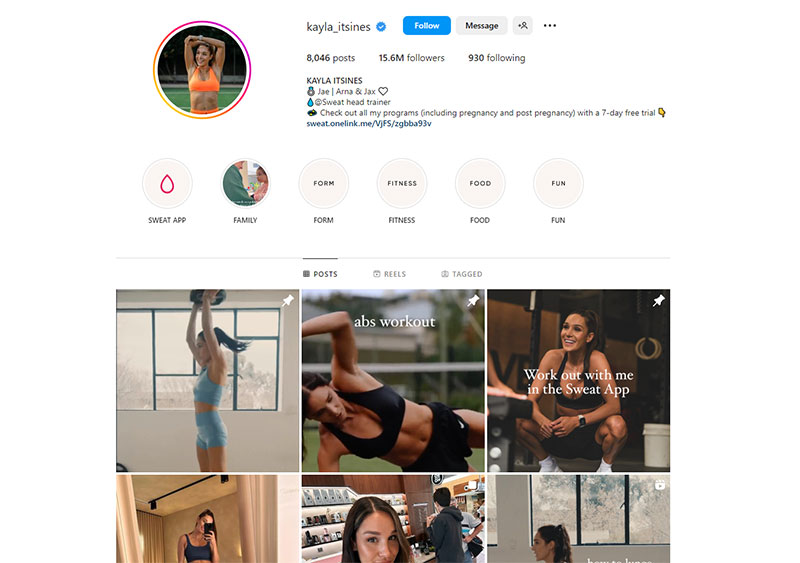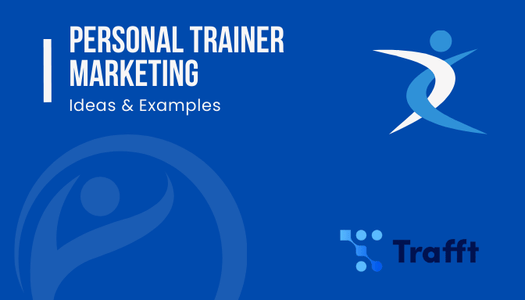The health and fitness industry has seen enormous growth in the past five to ten years. For many, becoming a personal trainer can be a very lucrative career choice. However, acquiring new clients is not always easy. That’s why utilizing effective personal trainer advertising tips is the key.
Marketing is one of the main components of running a successful coaching business. But spending too much time on personal training advertising can hurt more than help, especially if you are just starting out. You also need to allot time and money to offering sessions, creating workout plans, meal plans, and more.
In order to prepare you for success, we made this personal trainer advertising guide so your efforts are aimed in the right direction. We will also give you a lot of tips you can easily implement today!
Do Personal Trainers Need Marketing?
The short answer is yes, definitely! While it may seem like a huge effort and unnecessary expense to those who are just starting out their personal training business, this misconception could not be further from the truth.
Trainers often start their new business with a core of clients from a previous job. Thus, many find the initial stages easy. The difficulties come when it’s time to expand the personal training business because now you need to find new clients.
And without proper marketing how are people going to find you? Word of mouth is great for gaining new clients, but it’s highly unlikely it will bring you enough business. Taking matters into your own hands is necessary if you want to build a strong clientele and succeed in the fitness industry.
Having an appropriate marketing strategy for a personal trainer will help you take the crucial steps and advertise yourself the right way. You can also automate certain aspects of your marketing strategies and avoid the pitfalls of spending money in the wrong places.
Identify Your Target Audience
If you want your personal training marketing efforts to be successful, you first need to think about who your ideal customers are. Another thing to consider is your surroundings. For example, if you have many retirement communities in your area, it is wise to focus on training older people.
Some useful questions to ask in this regard are:
- What is their age group?
- What is their gender?
- What fitness level do they have?
- What interests and hobbies do they have?
- What is their demographic (students, stay-at-home moms, professionals, retirees)?
After research, you should have answers to these questions, and now you can put together a client profile. This profile will help you tailor your services to fit the audience better, and you’ll understand how to offer them correctly.
Why is identifying your target audience so important?
You shouldn’t waste your time and money trying to reach everyone. Focusing your efforts on a specific group of people will be far more effective. Otherwise, it is like throwing darts in the dark.
If you know your target audience, you can think about what they want and need, what problems they face, and what’s the best way to communicate with them. This way, you can create advertisement content that speaks to them and distribute it effectively.
Your money will go further, and your marketing efforts will be more effective, leaving you more time to work with your clients.
With a better personal training marketing plan, you’ll stand out from the rest. This way, potential clients can identify you as the expert and go-to person for specific fitness needs. And when you are well known, you can charge more for your services.
Methods for defining your ideal customer
Your ideal customer is the one you strive to reach with your marketing efforts. If you understand their needs and preferences, you are in a position to build an effective marketing strategy.
There are different ways to identify an ideal customer. One way is by conducting market research and gathering relevant information on things like
- Demographics
- Behavior
- Interests
- Purchasing habits
That information will help you gain more insight into how you can approach the specific audience.
A second method to describe your ideal customer is by looking at your current consumer base. Is there any pattern that emerges from your customer database? This pattern could relate to
- Age
- Buying behavior
- Gender
- Location
- Occupation
When you have identified one or more of those patterns, you can determine which of these is most profitable.
How to match your personal trainer advertising message with your target audience
Identifying and getting to know your target audience is the most important step. It is the foundation for the following steps. You can only tailor and target your message if you know who is supposed to respond to it.
People will respond better to a message that speaks to them on a personal level. That’s why your message should show how your service solves their problems. A general message that tries to appeal to everyone will appeal to no one. So, don’t be afraid to tackle the challenges your future clientele probably faces. Personalization is key; It helps establish a connection and show you understand their unique situation.
Here are some personal trainer advertising examples for a specific audience:
- Personal training for busy professionals. Professionals often struggle to find time to work on their fitness goals. Their busy work schedules are a limiting factor for them. Thus, many trainers have identified busy professionals as their target audience. They focus on offering services that are convenient and efficient. These services include home exercises and 30-minute workout session programs.
- Personal training for older adults. This is a smart choice in areas with an aging population. Seniors often have personal training needs that many trainers overlook. Their fitness goals include maintaining mobility and independence rather than building muscles. Be sure to use many offline advertising methods and include the benefits in the promotional material so it reaches the right audience.
- Personal training for new mothers. This is a good target because not many coaches work with new moms. Their needs include dealing with physical and emotional changes after childbirth. The things they look for in their fitness programs are personal touch, support, and kindness.
Create a Strong Brand
The brand of your personal training business is what people recognize and identify with. Your brand should thus communicate your values and philosophy. Because your audience should identify with it, it should also appeal to your target audience. That’s why this step is crucial when creating an effective personal trainer advertising strategy.
You can use your brand to promote your unique plan or exercise technique. Give your approach a memorable name. Later on, you can easily branch out into selling supplements or workout gear once your brand is established. This will separate you from everyone else who just provides personal training services.
Branding for your personal training business
Branding for your personal training business means finding a unique name, image, and logo. It is one of the things that sets you apart from the competition. It communicates your personality, values, and mission.
A word of caution to you: your branding also sets the expectations for your customers. A powerful way to establish your branding is by using elements of your story as a personal trainer. People love these origination stories; featuring them in your marketing materials will help clients connect with you. For example, say you lost 50 pounds thanks to your unique training program. Including this in your marketing efforts can make you appealing to those who have a similar goal.
Steps to develop a powerful brand
- Take a stance. Identify your values and unique approach. Make a message that sounds personal and consistent. Your message is not just that you are a personal trainer. But even more important, you must show you have a specific niche. You can, for example, say that you help busy professionals.
- Develop your own brand identity. Your brand is the visual representation of your business. Your branding includes a logo, color scheme, images, and typography. You should consistently use your branding everywhere on your website, social media links, and marketing materials.
- Craft your brand messaging. It should resonate with your audience and communicate your mission. Make it memorable and emphasize your unique selling point.
- Establish your brand voice. Through your voice, convey your style and tone. That tone should be consistent with your message, values, and identity. Be authentic, professional, and relatable.
- Be consistent. Be consistent in everything you do and publish. Your clients want certain reliability from you. Use the same tone when you speak or publish visuals, including images and videos. That helps clients to recognize you and understand the value of your personal training business.
Importance of consistent branding
Consistency builds trust and credibility and makes your brand memorable. Inconsistency confuses people and weakens the message you want to convey with your brand.
There are other reasons for being consistent in your branding:
- Brand recognition. Your customers can identify you
- Trust building. It helps your customers to know what to expect from your services. Trust also builds loyalty.
- Positive emotions. Clients start to associate your branding with quality, satisfaction, and other positive emotions.
- Differentiation. It sets you apart from other providers of personal training services.
Develop an Effective Marketing Strategy
Good personal trainer marketing ideas are important for a successful business. They help you reach your ideal customers and be more effective in your efforts. A strict definition of your marketing strategy increases your visibility and credibility. It will attract more customers. People can see that you are different from other personal training businesses.
Being consistent and having a good marketing strategy in place are some of the best personal trainer advertising tips we can give you. But in order to truly help you create it, we will cover how to market yourself as a trainer and craft an effective strategy step-by-step.
There are many different approaches to creating a marketing strategy, but here is a quick rundown of all the steps.
- Define your target audience. As discussed above, this is a very important step. With this information, you can tailor your personal training marketing strategy. It will make it more effective at a personal level.
- Identify your unique selling point (USP). Have a unique selling point that is clear and well-defined. Your USP will make you stand out and be easy to identify. This point tells people why they should choose you instead of someone else. Thus, it helps attract clients.
- Create social media pages for your business. Social media is important in your personal trainer marketing plan. It is easy, widespread, and free. Around 61% of people use some form of social media, and many of them use it to find products and services. Make the best use of these marketing channels.
- Spread printed marketing materials. Printed materials are one of the most effective marketing channels. It sounds old-fashioned, but do not underestimate their value. They build your brand and reach different parts of your audience.
- Work together with other businesses in the area. Partner with other businesses in the wellness industry, such as health food stores, to promote your business to people with a general interest in healthy living. Consider offering workshops, demonstrations, and other events.
Define Clear Goals
Your marketing strategy is the road toward your destination. Where do you see your business in a few months or a few years? That’s your goal. Now that you know your destination, it’s time to lay down a good personal trainer marketing plan. Every business is different. So, the objectives and goals of your personal training business are unique to you.
Identifying your business goals may be challenging, but it is necessary in order to create a personal trainer business plan. A clear framework can serve as a guide in the process. It helps you to put down in writing what you want to achieve.
One of the great ways to define goals is using SMART criteria. This method involves setting goals that are
- Specific
- Measurable
- Achievable
- Realistic
- anchored within a Time frame
When laid down this way, it’s much easier to see what you achieved and what needs to be worked on. Having a time frame helps you stay on track and focused with your marketing efforts.
Choose the Right Personal Trainer Advertising Channel
The digital world provides endless opportunities for online marketing. This is exciting, but it may be difficult to navigate and overwhelming.
Some may be tempted to use every single online marketing opportunity at their disposal. The reasoning could be that, in this way, they would bring in as many new clients as possible. But, you will be able to generate more quality leads if you focus on a few key channels your target audience uses the most. This way, you’ll most likely reach those who are more likely to hire your services.
Here are some questions that can help you focus your advertising efforts:
- Who comprises your target audience?
- Where can you find your target audience? What social media platform(s) do they use?
- Do they engage more with a vlog, a blog, an email, or a text message?
- What is your marketing budget?
These questions should help you identify the best ways to reach your specific audience and turn them into loyal clientele. But there are a few more factors to consider when choosing the right channels:
- Their interests. Only knowing who you want to reach will not be enough; you also need to consider their interests and behaviors. This will determine what’s the best way to interact with them.
- Your budget. Not every personal trainer has the same amount to spend on marketing. Failing to set the right budget can make or break your entire personal trainer advertising strategy. Also, the return on investment of each medium should be considered.
- Your goals. What do you want to achieve with your marketing strategies? What kind of message do you want to convey?
What advertising channels can you use?
Before choosing the best channel to use, you need to be familiar with what’s out there. Here are some of the most important advertising mediums:
- Social media advertising. For businesses, Facebook, Instagram, LinkedIn, and the X are the most effective. You can use them to get in touch with potential clients and build rapport. Many personal trainers have found that these platforms help to prove quality and expertise. A blog helps to get people interested and turn them into loyal customers.
- Advertising on Google. Google offers a pay-per-click paid advertising service. This is done by placing your ad on a Google search engine results page. In general, this form of publishing paid ads is very effective in directing traffic to your website and generating leads. The catch here is that you need to be familiar with how a search engine works so you can get the most out of these ads.
- Video advertisements. Video advertisements are very powerful. Nowadays, short-form video content is more popular than ever, and many prefer it compared to any other media channel. Getting on this wagon can help you generate a huge clientele, especially if you aim for younger generations.
- Email marketing. Personal trainer email marketing is one of the best ways to generate leads. Many underestimate the effectiveness of this channel, but the reality is that most people read their emails every day. To do it right, send out regular emails with good content. Avoid sending out only promotional emails, and use this opportunity to build a strong relationship with your audience.
- Printed advertisements. You can have your ads printed in local directories, magazines, and newspapers. This form of advertising reaches a local audience and people who do not use social media or the internet much. It weighs heavily on your marketing budget, and it is hard to measure its effectiveness, but it may be the best way to attract clientele if you aim for a more senior audience.
Comparing different advertising mediums
It is difficult to make qualitative and quantitative comparisons between different advertising mediums. What is right for one personal trainer may be wrong for another personal training professional. It also depends on your preference.
Still, this section will highlight some of the pros and cons of each advertising method for a self-employed individual.
Social media

- Pros
- Great for establishing and building customer relationships
- Wide reach and the potential for going viral
- You can target your advertising campaign in the most specific way
- Relatively cheap
- Cons
- Broadness of the audience. Users of social media have very different backgrounds which makes targeting hard
- Some users only socialize and do not look at ads
- Social media traffic focuses on the orientation stage rather than buying
- Branding on social platforms is harder for small businesses
- Hard to build appeal and awareness and generate traffic
Google Advertising
- Pros
- Specific targeting
- Analysis of effectiveness by monitoring traffic
- Instant results
- Potentially cost-effective
- Results are measurable
- Cons
- Many businesses focus on the same keywords
- Complexity of management
- Requires continuous monitoring and optimization
Email marketing
- Pros
- You can target the ones that are most interested in your services or products
- You can personalize your emails and increase engagement
- There is no limit to the length of your content marketing
- You can measure the effectiveness of your personal trainer email marketing campaign
- You control the presentation of your message
- Cons
- A cold approach sometimes frustrates and annoys the recipient
- Some customers receive hundreds or thousands of promotional emails per day and it is hard to stand out
- Preparing and mailing marketing emails have long lead times
- You may need to hire expert copywriters, photographers, designers, and others
Printed advertising
- Pros
- Printed ads are very effective for beginning personal training professionals
- Readers of newspapers, magazines, and brochures engage more strongly
- Reaches your local audience
- Tangible
- Strong in building brand awareness
- Cons
- Can be expensive
- You need to compete with many other advertisers
- Short life-cycle
- Environmental impact
Unlock Efficiency: Enhance Client Experience and Grow Your Revenue with Trafft
Are you tired of juggling appointments, schedules, and booking clients while still trying to focus on what you truly love – growing your personal trainer business?
Well, stress no more! Here’s the ultimate solution you’ve been searching for – Trafft. This fitness scheduling software is a game-changer for personal trainers.

Here’s the scoop on Trafft’s features:
- 🗓️ Booking made easy:
- Quickly create and customize your own booking page.
- Share the link with clients, and watch those appointments roll in.
- Say goodbye to back-and-forth emails!
- 🕒 Smart scheduling:
- Trafft optimizes your calendar based on your availability.
- Works in sync with your Google Calendar, iCal, or Outlook.
- 💳 Hassle-free payments:
- Accept payments online through integrations like Stripe and PayPal.
- Secure and reliable transactions? Check! 💯
- 🌐 Multilingual & multi-currency:
- Reach clients globally, as Trafft supports 30+ languages and multiple currencies.
- Perfect for expanding your photography business! 🌍
- 📲 Mobile-friendly:
- Trafft’s app works on any device, letting you manage your bookings on the go.
- 📈 Analytics & reports:
- Keep track of your business growth with detailed insights and performance reports.
- 🤝 Client management:
- Store client information securely and send out personalized reminders.
- 🛡️ Top-notch security:
- Trafft’s got your back with GDPR compliance and SSL encryption.
It’s time to bring your personal trainer business to the next level, and Trafft is just the tool you need! 🚀
Get started with Trafft and see the difference it makes in your work-life balance. You’ll be wondering how you ever managed without it!
Use Social Media the Right Way
When answering how to market your PT business, social media plays a big part. That’s why we will cover it in more depth so you can use it to your advantage. Social media is simple, effective, and, above all, it’s free. It gives you an opportunity to reach a huge audience, a much bigger one than with other advertising mediums. If you are an online personal trainer, this is the most effective form of finding new clients.
Another often-overlooked benefit is that it helps you connect with others in the fitness business. Being self-employed means that you need to handle certain issues on your own, but having a support system, even on social media, can help you deal with them much better. You will have someone to ask for advice or share experiences with, which is always a plus.
Choose the right social platforms and invest in them. That makes it more probable that you will reach your target customers. Facebook, for example, will be most effective in reaching women between the ages of 45 and 60. If that is your target audience, developing proper personal training in Facebook marketing may be the way to go. In this case, using TikTok will not reach your audience because TikTok users fall into a younger demographic.
Comparing popular social platforms for personal trainers
The social media landscape continues to change constantly. Choosing the right platform is important if you want your personal trainer advertising to be successful. We will briefly cover five of the most popular social networks for promoting your business as a personal trainer.
- Facebook. Facebook continues to be the most popular social platform. Each month, almost three billion individuals use it. You can create a business Facebook page, distribute targeted ads, and post content. It is ideal for interacting with your prospective and existing clients.
- Instagram. This social network lends itself to visual presentations. You can reach a large audience with it, as there are two billion monthly users. Share videos and progress photos, or communicate with your audience using direct messages and Instagram stories.
- TikTok. You probably have heard a lot about TikTok. Is it the right platform for you? That depends on your target customers. Most TikTok users belong to the Millenial and Gen Z generations. So, it is more suitable for targeting younger people.
- X. Previously known as Twitter, this platform is mostly used for the fast exchange of information. As a personal trainer, you can use it to share articles, quick thoughts, and updates on fitness. It allows for conversations with customers and networking with other fitness professionals.
- YouTube. YouTube is the largest platform for sharing videos. You can use it to share instructional and demonstrational videos or any other profession-related content. It is effective in establishing you as an authority in the fitness industry, and many people use it to find quick at-home workouts.
Personal trainer advertising tips for social media
You can be more successful in keeping existing clients and finding new personal training clients. And here are some tips for achieving just that:
- Address the problem. The first tip should not be a surprise. Research the demographic of your target audience. Know their motivations and the problems they face. Provide them with the perfect solution.
- Build a strong presence on the right social network. Create content with your audience in mind. That will be much more powerful than posting untargeted generic content on any platform.
- Use hashtags. Hashtags increase your content’s visibility, and you will reach a larger audience. Research the right and most effective hashtags in your field to help prospective clients find you.
- Keep a content calendar. Having a content strategy helps you to organize and plan the content on your social network pages. Keep in mind your message and audience, and schedule your posts so people stay engaged.
- Use high-quality visuals. Visuals are very powerful in conveying a message. Videos and photographs catch people’s attention and can give them an idea of your services. Make sure to use images of high quality that match your brand and communicate with the greatest effect.
- Analyze your performance. It is nice to have good results, but there is no reason to sit back and relax. Why do you have good results? Is there something in your content marketing that makes it different or appealing? Use the answers to those questions as the basis for the next successful campaign.
Leverage the Power of Business Automation
By automating some parts of your workflows, you can streamline your business operations and free up so much of your time. Some things that you could easily let the software handle are:
- Session scheduling
- Sending appointment reminders
- Analysis of your personal training clients by demographics or other parameters
In fact, there are many things in your day-to-day work that you could automate, including analytics, email marketing, lead nurturing, social media, and more.
Benefits of automation for personal trainer advertising
Personal training is almost always a one-man show, so the more you can automate, the better it’ll be for you. Automation allows you to focus on the more important things, like working with clients. Sitting behind a computer and trying to make people sign up is, for sure, not your favorite thing to do. If you decide to automate your marketing efforts, here are some benefits you can expect:
- Efficiency. The most important benefit of marketing automation is that it makes everything more efficient. Depending on your situation, you can reduce staffing costs or free up your own time. Ultimately, that will give you more time for your core activities and strategic growth projects.
- Personalized marketing content. By automating marketing, you can target your audience via different channels. They can find you on social networks, search ads, marketing emails, and other means.
- Improved lead capture. Automation is great for finding new leads and gathering their contact information.
- Streamlines customer management. After lead capture, customer management becomes very easy. You can work on your customer relationship in a very efficient and organized way. Options are sending reminders, follow-up messages, and other news. You can remind them of their fitness goals or motivate them to keep going.
- Accurate reporting. It is crucial that you stay on top of your business performance. Business automation is one of the tools that will help you do that. It allows you to see where problems arise and where you have growth opportunities. Accurate automated reporting is important in this process.
Popular marketing automation tools for personal trainers
You can find a wide range of marketing automation tools on the internet. This list shows some of the most popular solutions:
- Buffer is a free app for scheduling and social media post management. It is effective for various social platforms.
- Canva is also a free application. With Canva, you can create the perfect graphics for your website or other marketing outlets.
- MailChimp is a tool that you can use for free to create email newsletters and automated email campaigns. It also automates the maintenance of your list of subscribers.
- Sumo With this app, you can create pop-ups, buttons, forms, and other website features that can capture leads for your email list.
Measure Your Advertising Success
Now that we have answered how to market personal training and given you some practical tips, it’s time to see how you can measure it. After any marketing effort, you will want to know how well it worked. This way, you can identify strengths, weaknesses, and opportunities. The information gathered will allow you to create even better marketing campaigns in the future.
Importance of advertising success measurement
If the first step is success measurement, the second step will be effectiveness optimization. Measurement often starts right after the campaign or sometimes during the campaign. The one during the campaign allows for adjusting the balance between reach and relevance.
Tracking the effectiveness of a marketing strategy for a personal trainer has huge benefits. First, you will gain insights into which marketing channels and tactics are gathering the most conversions. Second, you will be able to perform real-time adjustments and optimization.
How to measure marketing success
- Analytic tools. Google provides Google Analytics, which delivers statistics on website traffic, bounce rates, page views, and conversions. You can determine which campaigns are most effective in directing traffic to your website. This data also shows what kind of traffic generates the most leads.
- Surveys. You can get feedback from clients and other consumers about your advertisements through surveys. They can tell you about their experience, and that will teach you what to keep and what to change.
- Social media metrics. Most social media platforms provide statistics on engagement and reach. You can use those statistics to determine which platforms are working best in your campaign. Then, adjust your efforts accordingly.
Key performance indicators for personal trainers
What are the most relevant key performance indicators (KPIs) when it comes to your advertising campaigns? Here are some of the statistics that personal trainers can look for:
- Click-through rates. Also called CTR, this indicator measures the number of people who click on a link or ad. This is an important statistic that shows how effectively your ad attracts people’s attention.
- Conversion and Return on Investment (ROI). ROI is one of the most important statistics for advertisers and marketers. It shows how much money you are making for every dollar you invest in your marketing campaign.
- Generated leads. The number of leads that your campaign generates indicates its effectiveness. It shows whether you are reaching your target audience or not. You can calculate this number from the number of leads captured through your website’s forms.
- Referral rates. As a personal trainer, you also want to generate leads from referrals. Referrals show how happy your existing clients are with your work. Again, that could reveal areas of opportunity. Client retention is the most important way to keep your business going.
Final Words on Personal Trainer Advertising Tips
Marketing a personal training business is a lot of work. But with some good personal training marketing ideas, you can ensure that you’ll always have plenty of customers.
First, you need to build strong relationships with your clients. At the same time, you need to handle the administration and management of your business. Balancing those elements is a struggle for many personal trainers. Don’t feel discouraged if you are struggling with that as well. You don’t have to be perfect right from the start, and you can make improvements along the way.
Apply the personal trainer advertising tips outlined in this article to your business. They will help you streamline your operations and attract more clients. Focus on these new clients and do what you do best, but don’t forget to put in extra effort with your existing clients as well. The workload can be a bit overwhelming, but utilizing booking solutions like Trafft can significantly improve your efficiency and free up some much-needed time.



